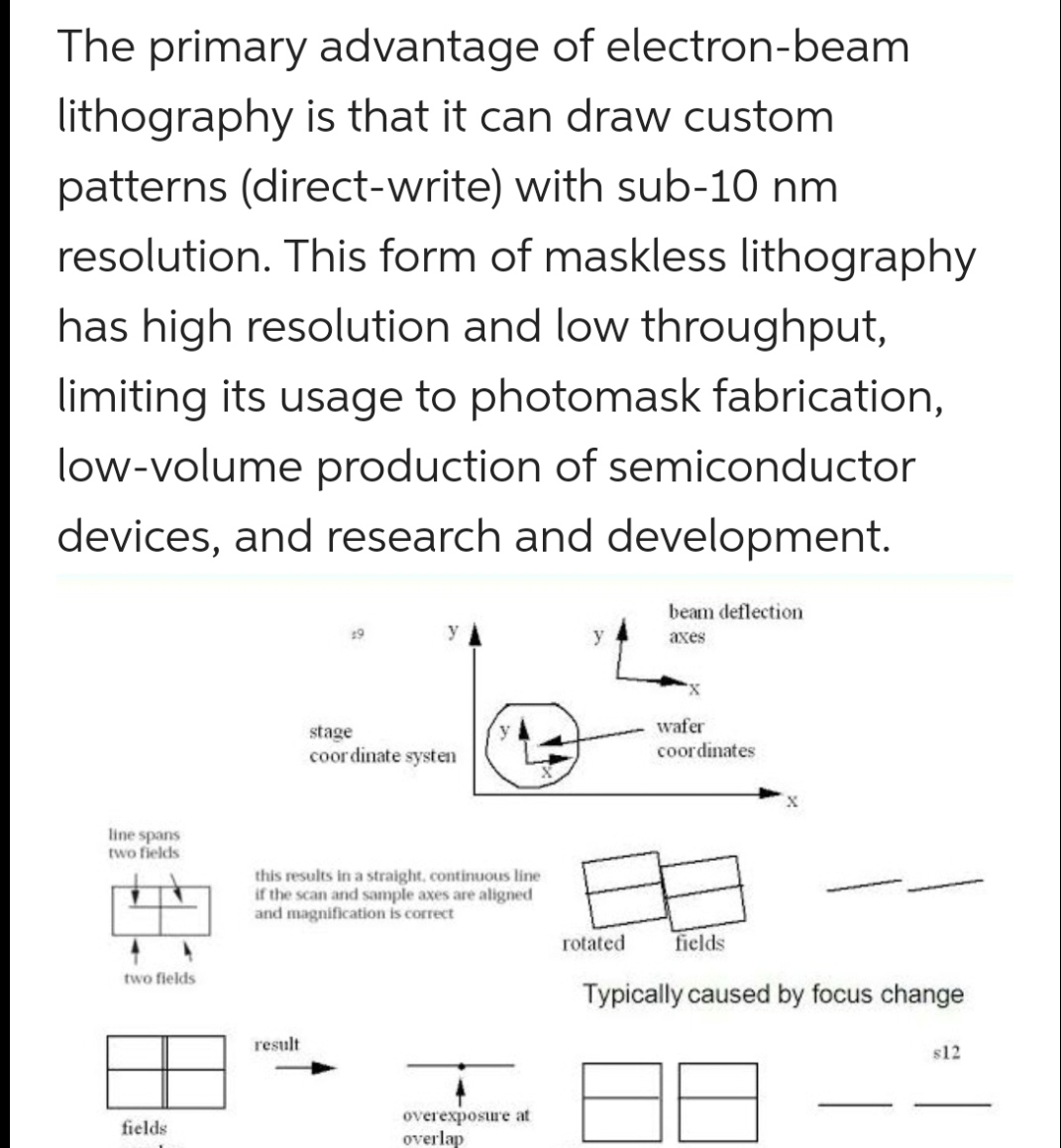Sherifs are proximity correction structures at the corners of lines: sherifs result in a more rectangular final shape compared with a simple rectangular initial shape. If the sherif size is half the feature size, calculate how the e-beam writing time is affected!
Sherifs are proximity correction structures at the corners of lines: sherifs result in a more rectangular final shape compared with a simple rectangular initial shape. If the sherif size is half the feature size, calculate how the e-beam writing time is affected!
College Physics
11th Edition
ISBN:9781305952300
Author:Raymond A. Serway, Chris Vuille
Publisher:Raymond A. Serway, Chris Vuille
Chapter1: Units, Trigonometry. And Vectors
Section: Chapter Questions
Problem 1CQ: Estimate the order of magnitude of the length, in meters, of each of the following; (a) a mouse, (b)...
Related questions
Question

Transcribed Image Text:**Title: Understanding the Role of Sherifs in E-Beam Lithography**
**Introduction:**
Sherifs are proximity correction structures used at the corners of lines in e-beam lithography. Their primary function is to enhance the final shape of the patterned area, making it more rectangular compared to a simple rectangular initial shape. This adjustment is crucial for achieving precise and desired outcomes in microfabrication processes.
**Explanation of Concepts:**
- **Sherifs**: These are small structures added to mask designs to correct distortions that occur during the patterning process.
- **Proximity Correction**: A technique intended to compensate for the undesired spreading of the electron beam during writing, which can cause features to deviate from their intended shapes.
**Impact on E-Beam Writing Time:**
When integrating sherifs, if the size is half the feature size, there must be a calculation on how this change affects the e-beam writing time. Typically, these adjustments may lead to increased exposure times due to the added complexity in the pattern structure.
**Diagrams and Their Significance:**
1. **Mask without Sherif:**
- **Illustration**: A simple square moves into a circular pattern.
- **Interpretation**: This transformation shows what typically happens when no proximity correction is applied; the intended shape becomes distorted (rounding of corners).
2. **Mask with Sherif:**
- **Illustration**: A square with extended corners (sherifs) moves into a more precise rectangular pattern.
- **Interpretation**: Highlighting the effectiveness of sherifs, this transformation demonstrates how the original mask design with sherifs helps maintain the intended rectangular shape after exposure.
**Conclusion:**
Incorporating sherifs in mask design for e-beam lithography is essential for minute precision in pattern making. By understanding and applying these proximity correction structures, engineers can ensure more accurate and reliable microfabrication outcomes.
Expert Solution
Step 1

Step by step
Solved in 2 steps with 2 images

Knowledge Booster
Learn more about
Need a deep-dive on the concept behind this application? Look no further. Learn more about this topic, physics and related others by exploring similar questions and additional content below.Recommended textbooks for you

College Physics
Physics
ISBN:
9781305952300
Author:
Raymond A. Serway, Chris Vuille
Publisher:
Cengage Learning

University Physics (14th Edition)
Physics
ISBN:
9780133969290
Author:
Hugh D. Young, Roger A. Freedman
Publisher:
PEARSON

Introduction To Quantum Mechanics
Physics
ISBN:
9781107189638
Author:
Griffiths, David J., Schroeter, Darrell F.
Publisher:
Cambridge University Press

College Physics
Physics
ISBN:
9781305952300
Author:
Raymond A. Serway, Chris Vuille
Publisher:
Cengage Learning

University Physics (14th Edition)
Physics
ISBN:
9780133969290
Author:
Hugh D. Young, Roger A. Freedman
Publisher:
PEARSON

Introduction To Quantum Mechanics
Physics
ISBN:
9781107189638
Author:
Griffiths, David J., Schroeter, Darrell F.
Publisher:
Cambridge University Press

Physics for Scientists and Engineers
Physics
ISBN:
9781337553278
Author:
Raymond A. Serway, John W. Jewett
Publisher:
Cengage Learning

Lecture- Tutorials for Introductory Astronomy
Physics
ISBN:
9780321820464
Author:
Edward E. Prather, Tim P. Slater, Jeff P. Adams, Gina Brissenden
Publisher:
Addison-Wesley

College Physics: A Strategic Approach (4th Editio…
Physics
ISBN:
9780134609034
Author:
Randall D. Knight (Professor Emeritus), Brian Jones, Stuart Field
Publisher:
PEARSON